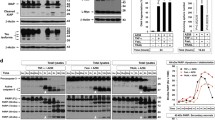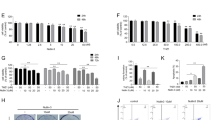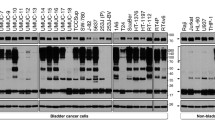Abstract
Cancer stem cells are capable of undergoing cellular transformation after commencement of apoptosis through the blebbishield emergency program in a VEGF-VEGFR2-dependent manner. Development of therapeutics targeting the blebbishield emergency program would thus be important in cancer therapy. Specificity protein 1 (Sp1) orchestrates the transcription of both VEGF and VEGFR2; hence, Sp1 could act as a therapeutic target. Here, we demonstrate that CF3DODA-Me induced apoptosis, degraded Sp1, inhibited the expression of multiple drivers of the blebbishield emergency program such as VEGFR2, p70S6K, and N-Myc through activation of caspase-3, inhibited reactive oxygen species; and inhibited K-Ras activation to abolish transformation from blebbishields as well as transformation in soft agar. These findings confirm CF3DODA-Me as a potential therapeutic candidate that can induce apoptosis and block transformation from blebbishields.






Similar content being viewed by others
Abbreviations
- Sp1:
-
Specificity1
- VEGFR2:
-
Vascular endothelial growth factor receptor 2
- VEGF:
-
Vascular endothelial growth factor
- PKC-ζ:
-
Protein kinase-C-ζ
- CHX:
-
Cycloheximide
- ROS:
-
Reactive oxygen species
- GST:
-
Glutathione-S-transferase
References
Goodwin Jinesh G, Willis DL, Kamat AM (2014) Bladder cancer stem cells: biological and therapeutic perspectives. Curr Stem Cell Res Ther 9:89–101
Jinesh GG, Chunduru S, Kamat AM (2012) Smac mimetic enables the anticancer action of BCG-stimulated neutrophils through TNF-alpha but not through TRAIL and FasL. J Leukoc Biol 92:233–244
Jinesh GG, Kamat AM. (2012) Redirecting neutrophils against bladder cancer cells by BCG and Smac mimetic combination. Oncoimmunology 1:1161–1162.
Jinesh GG, Laing NM, Kamat AM (2016) Smac mimetic with TNF-α targets Pim-1 isoforms and reactive oxygen species production to abrogate transformation from blebbishields. Biochem J 473:99–107
Jinesh GG, Lee EK, Tran J, Kamat AM (2013) Lenalidomide augments the efficacy of bacillus Calmette–Guerin (BCG) immunotherapy in vivo. Urol Oncol 31:1676–1682
Lee EK, Jinesh GG, Laing NM, Choi W, McConkey DJ, Kamat AM (2013) A smac mimetic augments the response of urothelial cancer cells to gemcitabine and cisplatin. Cancer Biol Ther 14:812–822
Metwalli AR, Khanbolooki S, Jinesh G et al (2010) Smac mimetic reverses resistance to TRAIL and chemotherapy in human urothelial cancer cells. Cancer Biol Ther 10:885–892
Takeuchi H, Taoka R, Mmeje CO, Jinesh GG, Safe S, Kamat AM (2016) CDODA-Me decreases specificity protein transcription factors and induces apoptosis in bladder cancer cells through induction of reactive oxygen species. Urol Oncol. doi:10.1016/j.urolonc.2016.02.025
Takeuchi H, Mmeje CO, Jinesh GG, Taoka R, Kamat AM (2015) Sequential gemcitabine and tamoxifen treatment enhances apoptosis and blocks transformation in bladder cancer cells. Oncol Rep 34:2738–2744
Tran MN, Goodwin Jinesh G, McConkey DJ, Kamat AM (2010) Bladder cancer stem cells. Curr Stem Cell Res Ther 5:387–395
Jinesh GG, Choi W, Shah JB, Lee EK, Willis DL, Kamat AM (2013) Blebbishields, the emergency program for cancer stem cells: sphere formation and tumorigenesis after apoptosis. Cell Death Differ 20:382–395
Jinesh GG, Kamat AM (2016) Endocytosis and serpentine filopodia drive blebbishield-mediated resurrection of apoptotic cancer stem cells. Cell Death Discov. doi:10.1038/cddiscovery.2015.69
Jinesh GG, Taoka R, Zhang Q, Gorantla S, Kamat AM. (2016) Novel PKC-ζ to p47(phox) interaction is necessary for transformation from blebbishields. Sci Rep 6:23965.
Jinesh GG, Kamat AM (2016) Blebbishield emergency program: an apoptotic route to cellular transformation. Cell Death Differ 23:757–758
Jinesh GG, Molina JR, Huang L, et al (2016) Mitochondrial oligomers boost glycolysis in cancer stem cells to facilitate blebbishield-mediated transformation after apoptosis. Cell Death Discov 2:16003.
Domingues I, Rino J, Demmers JA, de Lanerolle P, Santos SC (2011) VEGFR2 translocates to the nucleus to regulate its own transcription. PLoS One 6:e25668
Wang W, Bian K, Vallabhaneni S et al (2014) ERK3 promotes endothelial cell functions by upregulating SRC-3/SP1-mediated VEGFR2 expression. J Cell Physiol 229:1529–1537
Pore N, Liu S, Shu HK et al (2004) Sp1 is involved in Akt-mediated induction of VEGF expression through an HIF-1-independent mechanism. Mol Biol Cell 15:4841–4853
Liu N, Ding D, Hao W et al. (2016) hTERT promotes tumor angiogenesis by activating VEGF via interactions with the Sp1 transcription factor. Nucleic Acids Res
Akiyama H, Tanaka T, Maeno T et al (2002) Induction of VEGF gene expression by retinoic acid through Sp1-binding sites in retinoblastoma Y79 cells. Invest Ophthalmol Vis Sci 43:1367–1374
Reisinger K, Kaufmann R, Gille J (2003) Increased Sp1 phosphorylation as a mechanism of hepatocyte growth factor (HGF/SF)-induced vascular endothelial growth factor (VEGF/VPF) transcription. J Cell Sci 116:225–238
Higgins KJ, Abdelrahim M, Liu S, Yoon K, Safe S (2006) Regulation of vascular endothelial growth factor receptor-2 expression in pancreatic cancer cells by Sp proteins. Biochem Biophys Res Commun 345:292–301
Abdelrahim M, Smith R 3rd, Burghardt R, Safe S (2004) Role of Sp proteins in regulation of vascular endothelial growth factor expression and proliferation of pancreatic cancer cells. Cancer Res 64:6740–6749
Chintharlapalli S, Papineni S, Lee SO et al (2011) Inhibition of pituitary tumor-transforming gene-1 in thyroid cancer cells by drugs that decrease specificity proteins. Mol Carcinog 50:655–667
Park MT, Kim MJ, Suh Y et al (2014) Novel signaling axis for ROS generation during K-Ras-induced cellular transformation. Cell Death Differ 21:1185–1197
Anto RJ, Venkatraman M, Karunagaran D (2003) Inhibition of NF-kappaB sensitizes A431 cells to epidermal growth factor-induced apoptosis, whereas its activation by ectopic expression of RelA confers resistance. J Biol Chem 278:25490–25498
Negre-Salvayre A, Auge N, Duval C et al (2002) Detection of intracellular reactive oxygen species in cultured cells using fluorescent probes. Methods Enzymol 352:62–71
Eruslanov E, Kusmartsev S (2010) Identification of ROS using oxidized DCFDA and flow-cytometry. Methods Mol Biol 594:57–72
Brtva TR, Drugan JK, Ghosh S et al (1995) Two distinct Raf domains mediate interaction with Ras. J Biol Chem 270:9809–9812
Tuthill MC, Wada RK, Arimoto JM et al (2003) N-myc oncogene expression in neuroblastoma is driven by Sp1 and Sp3. Mol Genet Metab 80:272–280
Rickers A, Peters N, Badock V et al (1999) Cleavage of transcription factor SP1 by caspases during anti-IgM-induced B-cell apoptosis. Eur J Biochem 261:269–274
Rissman RA, Poon WW, Blurton-Jones M et al (2004) Caspase-cleavage of tau is an early event in alzheimer disease tangle pathology. J Clin Invest 114:121–130
Suh Y, Lee SJ (2015) KRAS-driven ROS promote malignant transformation. Mol. Cell Oncol 2:e968059
Zhao D, Pan C, Sun J et al (2015) VEGF drives cancer-initiating stem cells through VEGFR-2/Stat3 signaling to upregulate Myc and Sox2. Oncogene 34:3107–3119
Li JM, Mullen AM, Yun S et al (2002) Essential role of the NADPH oxidase subunit p47(phox) in endothelial cell superoxide production in response to phorbol ester and tumor necrosis factor-alpha. Circ Res 90:143–150
Kwan J, Wang H, Munk S, Xia L, Goldberg HJ, Whiteside CI (2005) In high glucose protein kinase C-ζ activation is required for mesangial cell generation of reactive oxygen species. Kidney Int 68:2526–2541
Pathi S, Li X, Safe S (2014) Tolfenamic acid inhibits colon cancer cell and tumor growth and induces degradation of specificity protein (Sp) transcription factors. Mol Carcinog 53(Suppl 1):E53–E61
Pathi S, Jutooru I, Chadalapaka G, Nair V, Lee SO, Safe S (2012) Aspirin inhibits colon cancer cell and tumor growth and downregulates specificity protein (Sp) transcription factors. PLoS ONE 7:e48208
Acknowledgements
The authors sincerely thank Dr. David J. McConkey (The University of Texas MD Anderson Cancer Center) for various reagents; Dr. Channing Der (University of North Carolina) and Dr. Santosh Chauhan (University of New Mexico) for plasmids (see GST pulldown section for details); Ms. Stephanie Deming for editorial help with the manuscript; and Ms. I-Ling Lee for technical help.
Author contributions
R.T. performed all experiments except those in Fig. 5, interpreted the data, and wrote the manuscript. G.J.G. conceived the hypothesis, designed the study, performed the experiments in Fig. 5 and prepared Fig. 6, interpreted the data, and wrote the manuscript. W.X. did part of the dose finding study. S.S. provided CF3DODA-Me. A.M.K. interpreted the data and provided scientific and editorial oversight.
Author information
Authors and Affiliations
Corresponding authors
Ethics declarations
Conflict of interest
The authors declare no conflicts of interest.
Ethical approval
All experiments comply with the current laws of United States of America.
Additional information
Rikiya Taoka and Goodwin G. Jinesh have contributed equally to this work.
Rights and permissions
About this article
Cite this article
Taoka, R., Jinesh, G.G., Xue, W. et al. CF3DODA-Me induces apoptosis, degrades Sp1, and blocks the transformation phase of the blebbishield emergency program. Apoptosis 22, 719–729 (2017). https://doi.org/10.1007/s10495-017-1359-1
Published:
Issue Date:
DOI: https://doi.org/10.1007/s10495-017-1359-1




